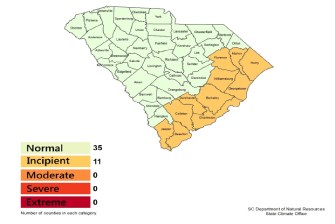SCDNR News
Drought Response Committee declares 'incipient' drought conditions in 11 counties
COLUMBIA, S.C.
March 22, 2022

Drought Response Committee declares 'incipient' drought conditions in 11 counties
The S.C. Drought Response Committee, meeting via conference call on March 22, upgraded the drought status to Incipient Drought for 11 South Carolina coastal counties (see map).
As designated by the South Carolina Drought Response Act, Incipient is the first level of drought followed by Moderate, Severe, and Extreme. Low streamflow conditions and below-normal top-soil and subsoil moisture were the primary driving factors leading to the drought declaration.
According to S.C. State Climatologist Hope Mizzell, the rainfall over the last 90 days has been below normal for our coastal counties. Some observers along the coast reported less than 5 inches since Dec. 22 which is 50 percent of normal. The lowest reported Community Collaborative Rain, Hail and Snow Network (COCORAHS) rainfall totals (Dec. 22-March 21) are 3.60 inches at Loris, 4.4 inches at Okatie, and 4.57 inches at Kiawah River. Elsewhere in the state rainfall has been close to normal or above normal. Seneca has received 17.96 inches, Tega Cay 14.04 inches, Aiken 11.58 inches and Camden 10.69 inches.
The U.S. Drought Monitor was one of the drought indicators supporting the upgrade. Elliot Wickham, S.C. State Climate Office water resources climatologist, explained that the current U.S. Drought Monitor map has all of coastal South Carolina in moderate drought (D1) and even after the recent rain the D1 designation will likely remain in place due to the rainfall deficit that has accumulated over the last 60 days.
According to Darryl Jones, forest protection chief for the S.C. Forestry Commission, 'Although some parts of the state have received enough rainfall to moderate conditions, wildfire occurrence has been higher than normal over the last two months, particularly along the coast. Where drought conditions are still in place, fires are easier to ignite and usually take more resources to suppress. In most years, peak wildfire activity occurs during March and April, and we expect those conditions this year due to dry, cured fuels combined with higher winds and low relative humidity associated with frontal passages.'
Priyanka More, SCDNR hydrologist, provided an update of the hydrologic conditions summarizing that rainfall in last two to three weeks helped bring declining streamflows back to their normal status for most of the state. However, for some of the streams near the coast the deficit was too significant and the recent rain not enough to increase flows. The recent flows at the Waccamaw and the Little Pee Dee gauges in Horry County are at or below the record low flows for this time of the year.
It is early in the growing season for many crops, but Blake Badger, Farm Service Agency district director, said dry conditions this early in the year are creating anxiety for some producers. Increasing temperatures will cause already dry conditions to further deteriorate, with the potential that some crops will not be planted.
Clint Elliott, lab supervisor for Grand Strand Water and Sewer Authority and representative from the Northeast Drought Management Area, discussed the dry conditions in Horry, Marion and Georgetown counties. According to Elliott, 'Even though the forecast predicts potential rain for our area in the coming days, the data we have to evaluate and the conditions seen around the counties as of now puts us into a deficit that will continue until a significant and soaking rain event brings the rivers and soils back to normal.'
Mizzell stressed that for the very low streamflows it will take a consistent pattern of normal rainfall to stabilize the flows. The South Carolina Drought Response Committee will continue to monitor conditions moving through the spring and will reconvene in late April.
Media Contact:
Hope Mizzell, SCDNR State Climatology Office, MizzellH@dnr.sc.gov
Priyanka More, SCDNR Hydrology, morep@dnr.sc.gov
Rob Devlin, SCDHEC, Devlinrj@dhec.sc.gov
Darryl Jones, S.C. Forestry Commission, djones@forestry.state.sc.us
Katherine Helms, S.C. Department of Agriculture, khelms@dnr.sc.gov



